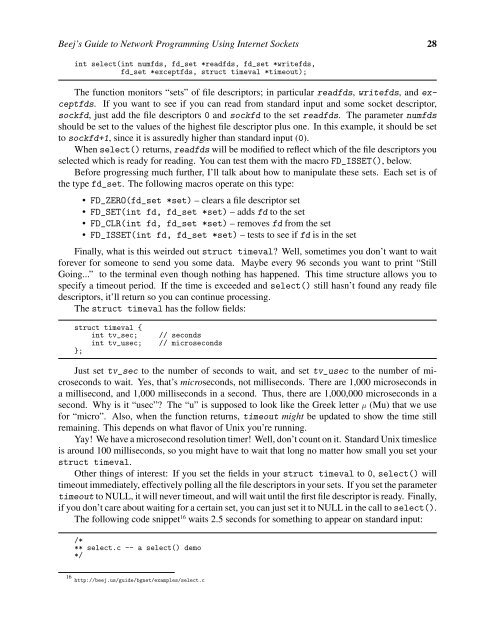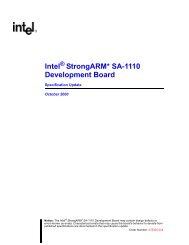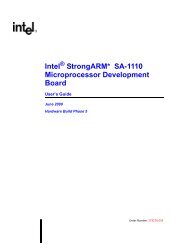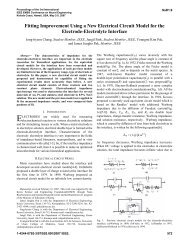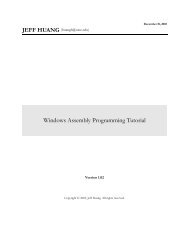Beej's Guide to Network Programming Using Internet Sockets
Beej's Guide to Network Programming Using Internet Sockets
Beej's Guide to Network Programming Using Internet Sockets
- No tags were found...
You also want an ePaper? Increase the reach of your titles
YUMPU automatically turns print PDFs into web optimized ePapers that Google loves.
Beej’s <strong>Guide</strong> <strong>to</strong> <strong>Network</strong> <strong>Programming</strong> <strong>Using</strong> <strong>Internet</strong> <strong>Sockets</strong> 28int select(int numfds, fd_set *readfds, fd_set *writefds,fd_set *exceptfds, struct timeval *timeout);The function moni<strong>to</strong>rs “sets” of file descrip<strong>to</strong>rs; in particular readfds, writefds, and exceptfds.If you want <strong>to</strong> see if you can read from standard input and some socket descrip<strong>to</strong>r,sockfd, just add the file descrip<strong>to</strong>rs 0 and sockfd <strong>to</strong> the set readfds. The parameter numfdsshould be set <strong>to</strong> the values of the highest file descrip<strong>to</strong>r plus one. In this example, it should be set<strong>to</strong> sockfd+1, since it is assuredly higher than standard input (0).When select() returns, readfds will be modified <strong>to</strong> reflect which of the file descrip<strong>to</strong>rs youselected which is ready for reading. You can test them with the macro FD_ISSET(), below.Before progressing much further, I’ll talk about how <strong>to</strong> manipulate these sets. Each set is ofthe type fd_set. The following macros operate on this type:• FD_ZERO(fd_set *set) – clears a file descrip<strong>to</strong>r set• FD_SET(int fd, fd_set *set) – adds fd <strong>to</strong> the set• FD_CLR(int fd, fd_set *set) – removes fd from the set• FD_ISSET(int fd, fd_set *set) – tests <strong>to</strong> see if fd is in the setFinally, what is this weirded out struct timeval? Well, sometimes you don’t want <strong>to</strong> waitforever for someone <strong>to</strong> send you some data. Maybe every 96 seconds you want <strong>to</strong> print “StillGoing...” <strong>to</strong> the terminal even though nothing has happened. This time structure allows you <strong>to</strong>specify a timeout period. If the time is exceeded and select() still hasn’t found any ready filedescrip<strong>to</strong>rs, it’ll return so you can continue processing.The struct timeval has the follow fields:struct timeval {int tv_sec;int tv_usec;};// seconds// microsecondsJust set tv_sec <strong>to</strong> the number of seconds <strong>to</strong> wait, and set tv_usec <strong>to</strong> the number of microseconds<strong>to</strong> wait. Yes, that’s microseconds, not milliseconds. There are 1,000 microseconds ina millisecond, and 1,000 milliseconds in a second. Thus, there are 1,000,000 microseconds in asecond. Why is it “usec”? The “u” is supposed <strong>to</strong> look like the Greek letter µ (Mu) that we usefor “micro”. Also, when the function returns, timeout might be updated <strong>to</strong> show the time stillremaining. This depends on what flavor of Unix you’re running.Yay! We have a microsecond resolution timer! Well, don’t count on it. Standard Unix timesliceis around 100 milliseconds, so you might have <strong>to</strong> wait that long no matter how small you set yourstruct timeval.Other things of interest: If you set the fields in your struct timeval <strong>to</strong> 0, select() willtimeout immediately, effectively polling all the file descrip<strong>to</strong>rs in your sets. If you set the parametertimeout <strong>to</strong> NULL, it will never timeout, and will wait until the first file descrip<strong>to</strong>r is ready. Finally,if you don’t care about waiting for a certain set, you can just set it <strong>to</strong> NULL in the call <strong>to</strong> select().The following code snippet 16 waits 2.5 seconds for something <strong>to</strong> appear on standard input:/*** select.c -- a select() demo*/16 http://beej.us/guide/bgnet/examples/select.c


